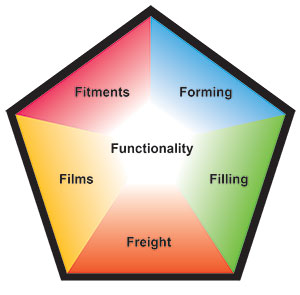For many small, medium and large brands, standup pouches (SUP) are being considered more and more as the premier package format to launch new products. Smaller and medium Consumer Packaged Goods companies CPGs, are using pouches as an easier, go-to-market product strategy with faster start up, lower capital investment while enjoying more package real estate for branding and differentiation from rigid packaging. For the consumer, on-the-go convenience, resealability along with new designs and improved functionality are leading to higher levels of pouch acceptance. For at least the last five years, toddlers in the US and Canada have grown very familiar and comfortable with functional pouches, enjoying juices, purées, puddings and now yogurts. For those of you interested in trends and demographics and its impact on packaging, it should not come as a surprise to see this younger generation grow and accept even more food and beverage product categories as they move to this flexible format.
Angie’s List for Pouches?
If you are considering launching a new food, beverage or home product for the first time in a pouch, no doubt you are scratching your head asking yourself where to start and who to call? Who has the expertise and quality standards to fill your food or beverage product? Should your pouch be made on a form/fill/seal line or should you take the pre-made path? What type of laminate film is going to be needed to protect your product? How should the product be dispensed and does it need a spout? These are a few of the important questions to ask as you enter into the journey with others who are already participating in the fastest growing packaging format.
As I thought about the outline for this article, I couldn’t help but think back to last year and my spring project of building a detached garage. To start the garage, I had little construction experience and little time. I needed help. I needed someone who could advise and pull together the right people and the companies who specialize in their respective field like pouring concrete, framing, insulating, roofing, and electrical and so on. For companies wanting to launch new products and start to plan their pouch project, I see similarities. There are many questions to answer, such as: where do I get pouches made, who specializes in filling my product, and what type of film or fitment should I use? As far as I know, there is no Angie’s List for SUP contractors. There are however, many knowledgeable suppliers who are willing to help you get started. Check out Flexible Packaging’s Suppliers Guide which can be found on their website.
Value in the Supply Chain
Let’s begin by looking at some of the stages in the supply chain and the value that each supplier provides in creating a functional pouch.
- Film-There are a number of large regional and global players producing multi-layer film laminations. These companies continue to develop product to meet market changing needs like high barrier films to protect product and extend product shelf life. One of the true benefits of flexible pouches versus rigid bottles is the variety of film offerings. These films can provide structure and stiffness or flexibility and suppleness. They can be completely clear and unprinted or printed with glossy, photographic qualities incorporating total opacity. Perhaps most importantly, the films can be designed in a way to “dial in” the appropriate barrier properties by application.
- Printing- Depending on run length and quality needed, common printing technologies for flexible packaging include flexography and rotogravure. Higher quality and longer runs are usually associated with the latter. Printers are linking with ink suppliers to bring advances in graphic design and consumer appeal like matte finishes, fluorescents, holographic, tactile and thermocromatic inks.
- Machine Supply- Major strides are being made with pre-made and form fill seal lines in areas of improved throughput and efficiencies through multilane indexing and rotary innovation. In addition, strides are being made in hygienic pouch filling (ESL, ultra-clean, aseptic), multiple shapes and fitment insertion.
- Pouch Forming- The pouch former (converter) manufactures the packaging in a facility with the appropriate quality control systems and provides flat pre-made pouches in whatever format the contract manufacturer requires. A benefit of using a pre-made pouch supplier is that the filling location can focus on the food or beverage production without having the added complexity of making the package as well. Pre-made pouches can be produced with or without spouts.
- Contract Manufacturing (fill/seal or form/fill/seal)- Fill seal applications take flat pre-made pouches supplied from the pouch converter and typically fills product through the open pouch or through a spout that was welded during the pre-made stage. After product is filled, the top of pouch is sealed bonding film to film or a spout/cap combination can be sealed into the open top. If the pouch is supplied to the contract manufacturer pre-spouted, an overcap is introduced post-fill and threaded to the spout providing a tight seal. Form fill seal lines receive printed film in rolls and in a continuous motion the pouch is converted, filled and sealed (with or without spouts).
- Closure Supplier- One of the truly key attributes of a functional pouch is the closure. Due to the virtually unlimited variety of pouch formats, pouch fitments can be much more functional then merely a means to dispense product. Surely, pouch fitments (spouts and overcaps) provide directionality when product is poured or squeezed, resealability when the product is a multi-use or serve and protection and convenience when product is sipped or sucked from the pouch. However, fitments can also be placed into pouches in locations impossible for rigid, providing a much wider variety of dispensing options. Different size and shape options are available, along with value-added features like Aptar’s Simplisqueeze® anti-spill valve technology. Aptar is leading the industry in developing consumer friendly and child safe fitments that meet or exceed the expectations of the CPGs.
The Six Fs

Companies in the pouch supply chain can help guide you along each of the steps. Partnering with a trusted supplier or hiring a consultant, for example, Packaging Specialists, will help to move the process along. Pouch converters and contract manufacturers (fillers or co-packers), can provide a more holistic view of the pouch options as they are further down the supply chain. However, because you know your customer better than any of the suppliers, you will need to kick-start the process by helping the supplier(s) understand the specific needs your product, its application, its positioning in the market. In other words, what functionality do you want the pouch to deliver?
Functionality is the first and most critical of Six Fs (Functionality, Films, Fitments, Forming, Filling, Freight) that needs to be considered in building your pouched product. Knowing how you want the pouch to function for your products through the entire supply chain will help drive the remaining Fs. However, to ensure a successful roll-out of a new pouch in the market requires diligence. There is no one route to market. Failure to properly execute all of the Six Fs will lead to problems, often severe enough to jeopardize the entire product launch.
The CPG considering a foray into pouches needs to understand and execute the Six Fs:
Function:
- Who is my target market? How do I want my consumer to interact with my package?
- Generally, how do I want the pouch to look? (Don't assume today’s pouches are the only options!)
- Are there a variety of products being considered? Are there ways to incorporate features other than just graphics to standardize the product line (shapes, fitments, sizes)?
Film:
- What physical properties does your pouch need?
- Does your product need laminate barriers for special shelf life needs or harshness of product?
- Do you want the consumer to see the product inside the SUP?
- Are there special processing considerations (hot-fill, retort, etc.) that require specific films or film properties?
Forming:
- How will the consumer handle the pouch?
- What shape will provide your product with the best look, feel and best way to dispense?
- What are the pros/cons of pre-made vs form/fill/seal?
- Will my pouches need fitments or other features? If so, where and how will those features be incorporated?
Filling:
- What type of filling machine will fill my pouches?
- Does that filler require a specific pouch type?
- In what format are the pouches loaded into the filler (rolls, magazine, rails, etc.)?
- If the product is food or beverage, what type of filling is needed, e.g., hot fill, retort, aseptic?
Fitment:
- Does the pouch need to be resealed, need a controlled pour, a spout to feed from?
- What size of opening (orifice) is needed to pour or squeeze your product?
- Does the fitment of choice work on the pouch forming and/or pouch filling equipment?
Freight:
- This is the most overlooked of all of the considerations for pouches. However, if not executed properly, the freight and distribution channel can destroy the best, strongest pouches.
- What is the most appropriate secondary packaging for filled pouches?
- How will the pouches be displayed at retail?
- How will the filled pouches be shipped (truck, rail, container)?
Before entrusting my contractor to manage the build of my garage, it was it important for me to be part of the planning and having an understanding of how and what materials my garage was going to be built with. At the end of the day, I was still in charge and ultimately responsible for the end product.
As the brand owner ultimately responsible for the product sitting on the store shelf, knowing what you want from your package leads to how the product is being made and filled and knowing who in the supply chain was responsible for creating and managing the quality of your product. This may be even more important than building a detached garage.
Let the build begin!




